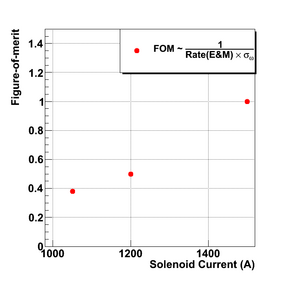Difference between revisions of "Experimental Sensitivity to Solenoidal Field"
From GlueXWiki
(→References) |
(→Figure-of-Merit) |
||
| Line 14: | Line 14: | ||
* Sensitivity ~ time x luminosity / sqrt (time x luminosity x width) ~ sqrt (time x luminosity / width) ~ sqrt (time / (<math> R_{EM}</math> x width) | * Sensitivity ~ time x luminosity / sqrt (time x luminosity x width) ~ sqrt (time x luminosity / width) ~ sqrt (time / (<math> R_{EM}</math> x width) | ||
* For constant sensitivity, the experimental run time ~ <math> R_{EM} </math> x width = 1/FOM. | * For constant sensitivity, the experimental run time ~ <math> R_{EM} </math> x width = 1/FOM. | ||
| − | We note that the calculated rates give <math> R_{EM} \sim 1/B^2 </math>, and <math>\sigma_{\omega} \sim 1/B </math>, which leads to <math> FOM \sim | + | We note that the calculated rates give <math> R_{EM} \sim 1/B^2 </math>, and <math>\sigma_{\omega} \sim 1/B </math>, which leads to <math> FOM \sim B^3 </math>. See figure below: |
[[Image:Plot resolutions c5.png |thumb|left|300px|FOM ~ 1/(R_EM x omega width)]] | [[Image:Plot resolutions c5.png |thumb|left|300px|FOM ~ 1/(R_EM x omega width)]] | ||
Revision as of 18:18, 27 April 2010
References
- GlueX-doc-1425 Magnetic Field Studies Status
- GlueX-doc-1471 Electromagnetic Background Rate Studies (for different solenoid magnet fields and FDC hole sizes)
- GlueX-doc-1469 Studies of particle reconstruction for $\omega$ and X(2000) events
Figure-of-Merit
We construct a Figure-of-Merit (FOM) based on the calculated electromagnetic background rates in the detector and the resolution for reconstructing omega mesons. The validity for this FOM is based on the following argument:
- Statistical sensitivity ~ signal/sqrt(background)
- signal ~ time x luminosity
- background ~ time x luminosity x width of signal peak
In addition, we assume that the luminosity is limited by the rates in the detectors, which is dominated by electromagnetic background. Therefore
- luminosity ~
 , where
, where  is the rate in one of the inner detectors, either the start counter or the FDC. (We use the start counter rate)
is the rate in one of the inner detectors, either the start counter or the FDC. (We use the start counter rate)
Therefore,
- Sensitivity ~ time x luminosity / sqrt (time x luminosity x width) ~ sqrt (time x luminosity / width) ~ sqrt (time / (
 x width)
x width) - For constant sensitivity, the experimental run time ~
 x width = 1/FOM.
x width = 1/FOM.
We note that the calculated rates give  , and
, and  , which leads to
, which leads to  . See figure below:
. See figure below:
